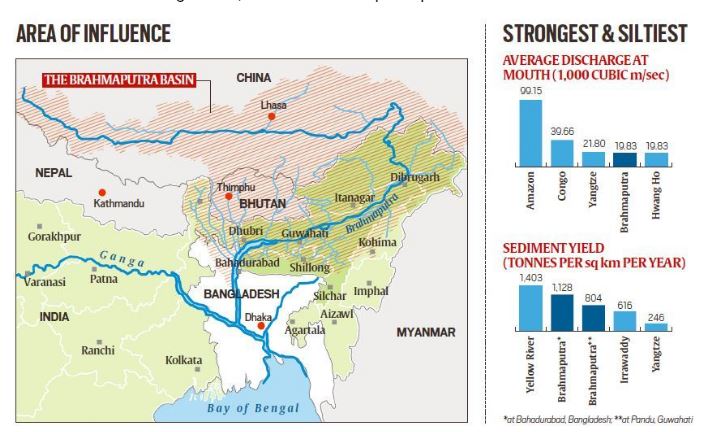What is the issue?
- Assam is in the grip of yet another flood, with lakhs of people displaced and some killed, besides hundreds of animals.
- In this context, here is a look at why Assam has traditionally been flood-prone and an assessment of the measures taken.
Why are floods so destructive in Assam?
- Apart from heavy and constant rainfall during the monsoon, there are many contributory factors, both natural and man-made that make floods so destructive in Assam.
- Brahmaputra - The very nature of the river Brahmaputra is dynamic and unstable.
- Its 580,000 sq km basin spreads over four countries (China, India, Bangladesh and Bhutan) with diverse environments.
- The Brahmaputra features among the world’s top five rivers in terms of discharge as well as the sediment it brings.
- The vast amount of sediment comes from Tibet, where the river originates.
- Tibet is a cold and arid region, and lacks plantation. Glaciers melt, soil erodes and all of it results in a highly sedimented river.
- On the other hand, Assam primarily comprises floodplains surrounded by hills on all sides.
- So, by the time the Brahmaputra enters Assam, i.e. from a high slope to a flat plain, its velocity decreases suddenly.
- This results in the river unloading the sediment.
- Also, following the devastating earthquake of 1950, the level of the Brahmaputra rose by two metres in Dibrugarh area in eastern Assam.
- Because of the earthquake-prone nature of the region, the river has not been able to acquire a stable character.
- So the river’s channels prove inadequate amid the siltation, in turn, leading to erosion and floods.

- Man-made factors - Besides the natural factors are the man-made ones which lead to higher sedimentation.
- These include habitation, deforestation, population growth in catchment areas (including in China), etc.
- For instance, the sediment deposition itself creates temporary sandbars or river islands.
- It is common for people to settle in such places, which further restricts the river flowing space.
- When rainfall is heavy, it combines with all these factors and leads to destructive floods.
How effective are the flood control measures?
- Dams - In its master plan on the river in 1982, the Brahmaputra Board had suggested that dams and reservoirs be built to mitigate floods.
- However, the idea of dams has traditionally been a double-edged sword.
- One of objectives of dams is to regulate the release of flood waters.
- But, the release, when it comes, can sometimes be beyond the capacity of the channels downstream, further leading to floods there.
- In the Brahmaputra basin, there were protests against dam-building plans on grounds of displacement and destruction of ecology.
- All these prevent the plans from moving forward.
- Embankments - Given the above, the government has been using only one approach towards floods, which is building embankments on the river.
- Embankments were proposed only as an interim and ad hoc measure for short-term mitigation and thus, they lack durability.
- Since they were temporary measures, the government did not spend on high-specification embankments, and so, are weak and are regularly breached.
- Dredging - The government also considered dredging (digging up the riverbed and making the river deeper).
- However, this is not a wise idea given the fact that Brahmaputra sediment yield is among the highest in the world.
- Even if the silt is taken out this year, more silt will be deposited the following year, making the very expensive effort futile.
- Overall, most of the government’s measures have been piecemeal and short-term, and the problem is not addressed at the source.
What could a sustainable solution be?
- Addressing the issues only in Assam, when the flood strikes, could not be long-term solution.
- There has to be a “basin-wide approach” to the flood problem of Assam.
- An “integrated basin management” system should ideally bring in all the basin-sharing countries on board.
- The countries should come to an understanding about taking measures in the catchment areas.
- For this, the inter-state relationships, political cooperation and the role of the government are important.
- Flood-plain zoning is another measure in which depending on the vulnerability of the area it is divided into different categories.
- Accordingly, certain activities such as farming, building a house, etc are banned.
Source: Indian Express